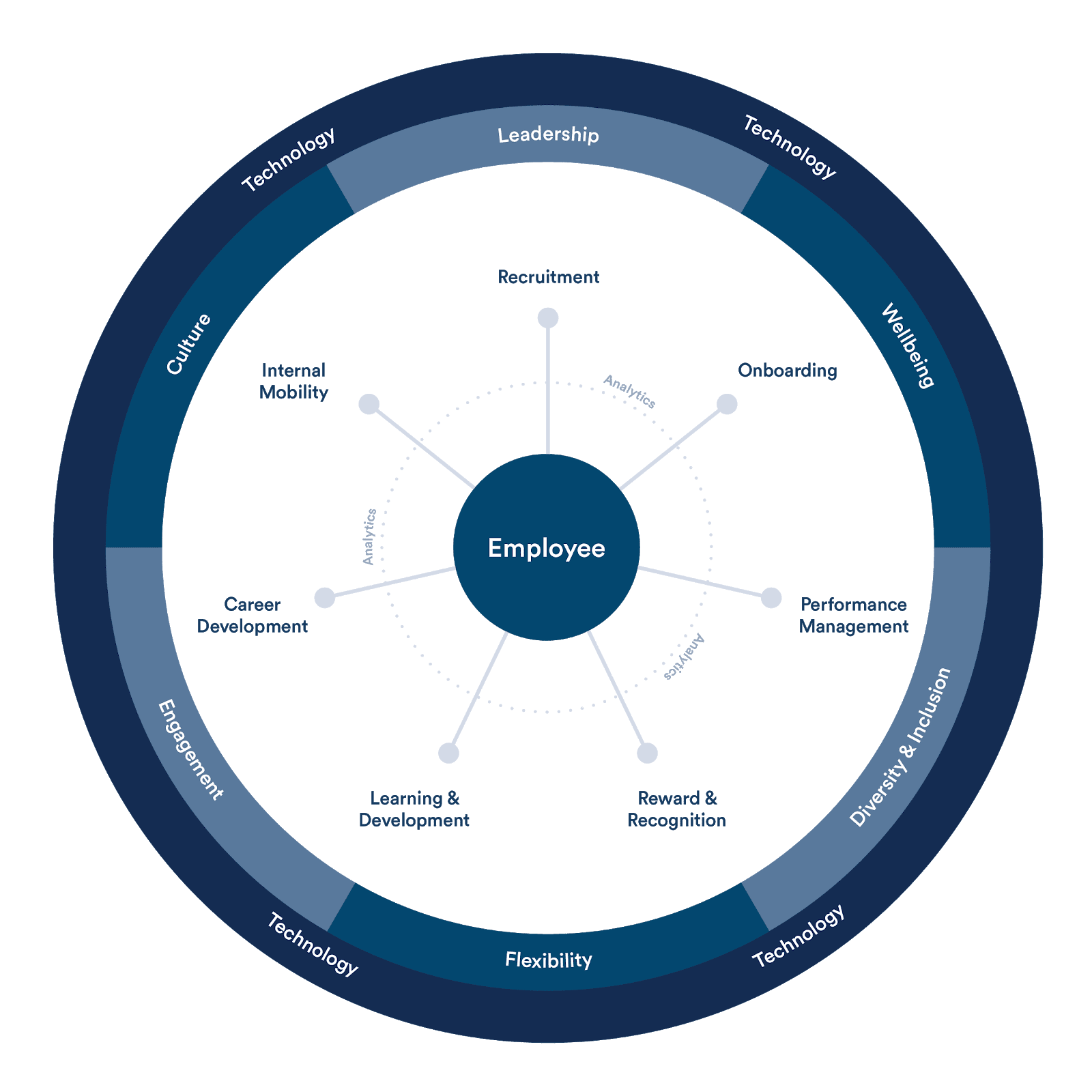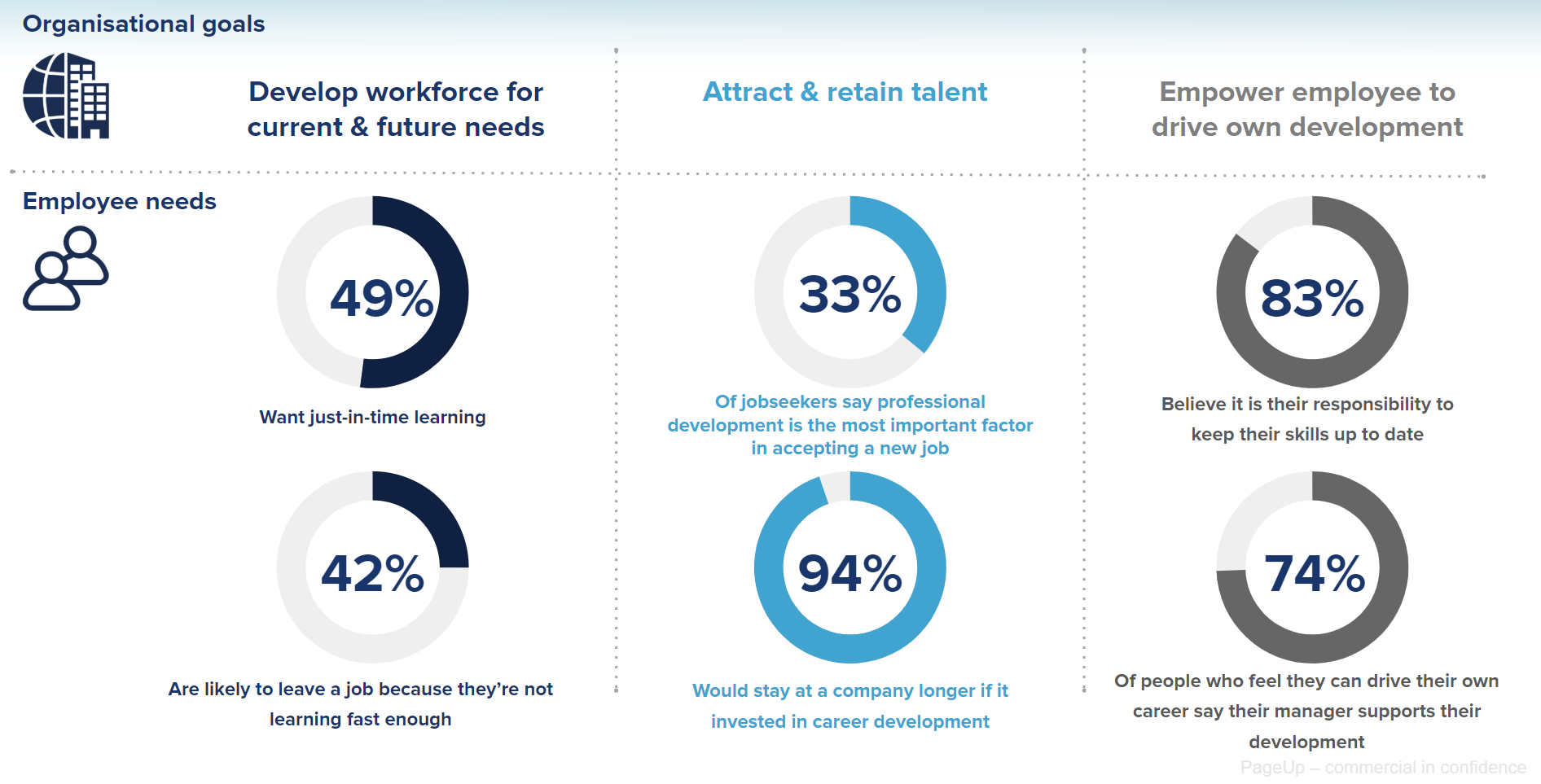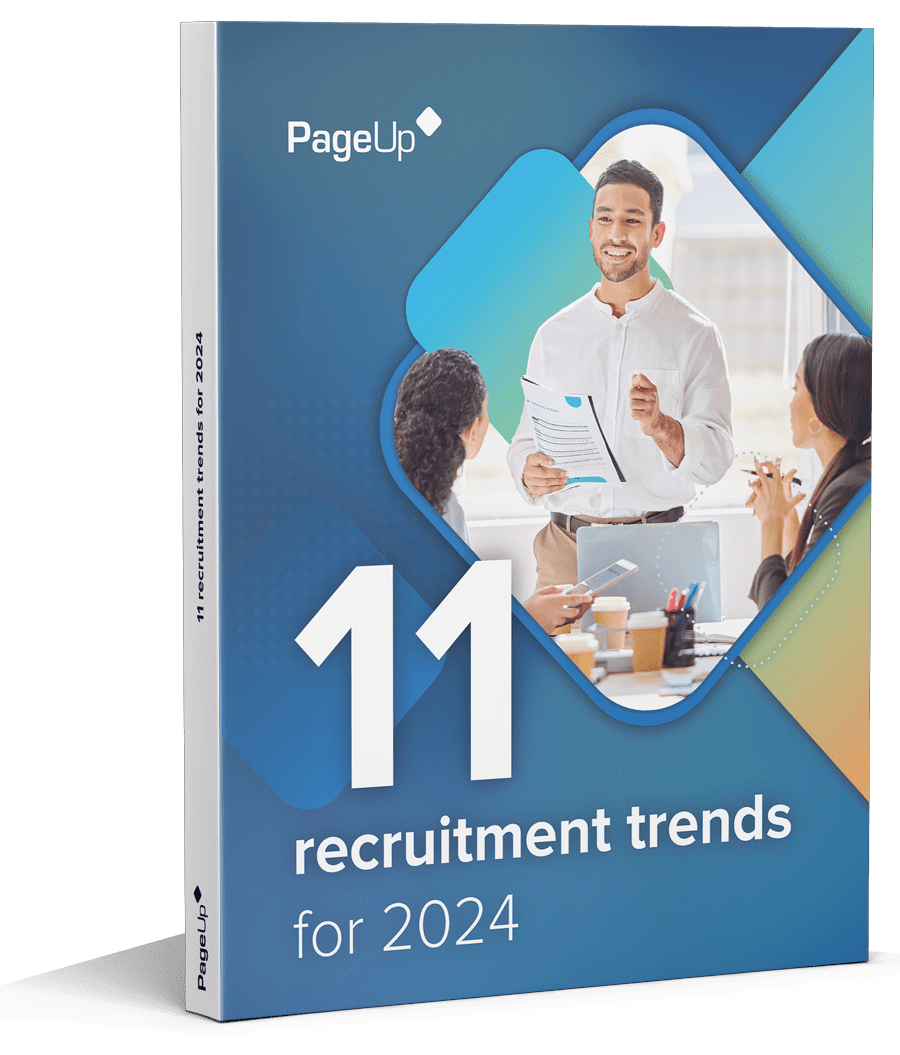In today’s talent market, employee engagement and retention are more important than ever. Approaching talent management with an employee-centric lens is crucial to providing a great employee experience —which is key to retaining your top talent.
- The rise of quiet quitting
- The PageUp talent management framework
- Culture and employee wellbeing
- Recruitment, onboarding and employer brand
- Performance management and rewards
- Learning and career development
- Internal mobility
When it comes to talent management, employees are now in the driver’s seat. To attract, develop and retain talent, HR leaders are shifting from a top-down, hierarchical approach to one focused on creating a positive, empowering employee experience.
Instead of focusing solely on how to get the most out of employees (or perhaps to ensure they do), leaders are considering how they can create an experience and environment that attracts, develops and retains the best people. Eighty per cent of executives rate employee experience as important – but 59% admit they’re not ready for the challenge.
In the wake of the Great Resignation, and increasing employee burnout, retaining talent is no longer a “nice-to-have”—it’s an essential part of today’s recruiting strategy. With more open roles than available applicants, it’s not as simple as backfilling a role. Now, the best recruitment strategy is to keep the team you’ve got.
Creating a great employee experience is vital to keeping employees engaged and achieving organisationalorganizational goals. OrganisationsOrganizations, where employees are highly engaged, have higher productivity, customer satisfaction and profitability.
The rise of quiet quitting
A challenging few years with the pandemic and the flow-on economic instability have given rise to a new workforce phenomenon: quiet quitting. The term was coined to reflect workers who only do their jobs as described in their job description. No extra hours, no above-and-beyond. While some may see this as setting healthy boundaries (a good thing for employees to do), the sentiment behind the phrase is more concerning: it’s a clear indication of burnout and a workforce calling for help.
Whether it’s caused by poor conditions, external stressors, lack of leadership, or overwork, there is a clear link between burnout, quiet quitting and employee engagement. By prioritising a positive employee experience and working hard to keep employees engaged, companies can reduce burnout and create a space where establishing work-life balance is encouraged.
How can companies reimagine the talent lifecycle talent management to create an exceptional employee experience which is aligned with organisationalorganizational productivity goals? Enter: the PageUp Talent Management Framework.
PageUp Talent Management Framework
 The PageUp Talent Management Framework puts the employee at the centrecenter
The PageUp Talent Management Framework puts the employee at the centrecenter
An employee-centric approach to talent management
An organisationorganization’s approach to all aspects of talent management should deliver an exceptional candidate and employee experience.
The employee is at the centrecenter of the employee-centric talent management framework, with all aspects of talent management processes and people practices designed with the employee experience in mind. This is integral to creating a great employee experience that keeps people engaged and motivated.
An employee-centric framework allows information and data to flow seamlessly from one talent management process to another without silos. It gives people confidence that performance reviews, development plans, learning outcomes and career discussions lead to transparent and equitable access to rewards and recognition, development opportunities and internal mobility.
Technology is placed in the outer circle because it supports each stage of the employee journey. From recruitment, onboarding, performance, recognition and reward, learning and career development and internal mobility – technology drives efficiency and creates a seamless experience from the employee’s perspective.
Culture and employee wellbeing
An organisationorganization’s culture underpins every aspect of its talent management. To unleash the potential of people, organisationsorganizations need to create an environment that engages employees and entices others to join. People need to:
- feel comfortable bringing their authentic selves to work
- feel inspired and valued
- be supported by leaders, managers and team members
- be recognisedrecognized for their accomplishments
- be given opportunities for learning and career development.
Highly-engaged employees are aligned to the mission and values of your organisationorganization. OrganisationsOrganizations need to understand the highly personal and individual nature of engagement – and how it can influence business outcomes.
Creating a culture that increases employee engagement starts with leadership. Strong vision and support from leaders is required to transform talent management to focus on employee experience. Managers need to move beyond quotas, compliance training and ticking diversity boxes to become coaches, developing people for current and future roles.
In a bid to support health, wellbeing and work-life balance, organisationsorganizations will need to create greater flexibility for both where and when people work and how the work is done.
Providing flexible working options benefits team wellbeing —allowing staff to work when and where suits them. By empowering team members to take control of their work days, employers can combat burnout and quiet quitting, and encourage a culture of trust.

Today’s employees are prioritising work-life-balance, mental health and overall wellbeing. Supporting employees to find that balance is crucial to retain talent.
Recruitment, onboarding and employer brand
Taking a candidate-centric approach to recruitment is vital to win the war for talent. Today’s candidates vote with their feet and demand a consumer-grade experience. Their recruitment experience will determine if they want to work for you, or a competitor. On average 14% of millenials and Gen X jobseekers say that they would decline an offer based on a lack of HR tech in the application process. An even greater 26% of Gen Z candidates would decline a job offer based on this lack of tech. The onus is on organisationsorganizations to leverage technology to provide a seamless, hassle-free recruitment process.
To attract and retain the best talent, organisationsorganizations need to take a two-pronged approach: create a seamless and engaging candidate experience that also creates superior outcomes for the organisationorganization. OrganisationsOrganizations want the right people, in the right role at the right time. A carefully-considered employer brand and employee value proposition is essential to attracting quality talent.
75% of jobseekers research a company before even applying for a role, which means an attractive employer brand is a must to tempt top talent. Companies with great employer brands receive 50% more qualified applicants and see a 50% reduction in cost-per-hire, according to LinkedIn research.
People want to work for organisationsorganizations where the culture, mission and values align with their personal values. Creating, communicating and showcasing an appealing employee value proposition (EVP) on social media, careers sites and throughout the recruitment process is critical to attracting high-calibre talent.
Beyond first impressions, organisationsorganizations are optimising the entire recruitment process to reflect their employer brand. Prioritising candidate experience not only creates a strong employer brand – it also influences corporate brand reputation. Many candidates are current or potential customers: if they have a poor recruitment experience, they may choose to take their business elsewhere.
Finding and attracting talent is an ongoing battle for many organisationsorganizations, but it doesn’t need to be. Hard-to-fill roles and volume recruiting can be optimisedoptimized by having pools of warm candidates and building continuous pipelines of talent. High-quality unsuccessful candidates or silver medalists should also be added to talent pools. This empowers hiring teams to connect with qualified, pre-screened applicants for future roles: improving the experience for both candidates and hiring managers.
Effective onboarding is just as important as recruiting the right people. 20% of turnover occurs within the first 45 days of work, which means getting it wrong can have a huge impact on an organisationorganization’s retention strategy —and its bottom line. Done well, onboarding introduces new hires to the people, tools and experiences that will help them be successful and sets the tone and expectations for what’s to come. When onboarding is a seamless continuation of a positive recruitment experience, it reinforces employee engagement and ensures new hires hit the ground running. It’s the first, critical step in the employee’s continuous learning journey.
When organisationsorganizations get onboarding right, new hire productivity increases by 62% and retention of new hires increases by more than 50%.
Related reading: The ultimate guide to employer branding
Performance management and rewards
The employee-centric talent management framework enables delivery of a seamless, employee-centric recruitment and onboarding experience to set people up for success. As people settle into their roles, how do you keep them as engaged and enthusiastic as they were on day one? The answer lies in everyday performance management that’s linked to flexible reward and recognition initiatives.
The fundamentals of performance management – aligning people to business goals, evaluating and providing feedback, recognising and rewarding high performers – should drive productivity and lead to engagement. But traditional yearly performance reviews have failed to deliver.
In response, many organisationsorganizations have shifted to continuous feedback models to improve employee engagement and productivity. Already 76% have reinvented performance management to be more continuous and 81% of organisationsorganizations are planning to, or have shifted to regular performance discussions which are focused on future career and development.
As well as improving engagement and productivity, regular feedback enables:
- relevant and timely learning and development opportunities to be identified;
- people to be continuously reconnected to organisationalorganizational goals;
- organisationalorganizational agility: the ability to quickly pivot and realign objectives in response to changing business needs.
In an employee-centric talent management framework, performance management is built on a foundation of ongoing feedback, recognition and improvement. Effective performance management should:
- connect employees to the purpose and mission of the organisationorganization by clearly articulating how personal objectives contribute to achieving organisationalorganizational goals;
- help employees to craft their own KPIs or objectives. Those who are brought along on the goal-setting journey are 3.6 times more likely to be engaged than those who are not;
- create a high-performance culture by embedding ongoing feedback and recognition into day-to-day people leadership. Regular constructive feedback increases confidence and helps people identify areas for improvement.
One of the challenges for many organisationsorganizations is a timing misalignment between performance feedback and reward. Although over three-quarters of organisationsorganizations are moving to a continuous feedback model, less than 10% are adjusting salaries more than once a year.
How can organisationsorganizations align rewards with the new era of continuous performance management to create a great employee experience?
- Tailored rewards: When it comes to rewards, one size does not fit all. By understanding individual motivators, organisationsorganizations can create meaningful, diverse and personalisedpersonalized rewards. Currently, only 8% of organisationsorganizations say that their rewards program is ‘very effective’ at creating a personalisedpersonalized, flexible solution. For rewards programs to have a positive and lasting impact, they need to be designed with employees, for employees.
- Increased frequency: people who receive regular small rewards – even verbal acknowledgement or thanks – are 8 times more engaged than those who only receive an annual bonus.
Transparent and fair processes: The organisationorganization needs to communicate the process for allocating rewards clearly to employees, and these processes need to be perceived as fair and equitable. Employees who do not understand the pay process are 60% more likely to leave the organisationorganization. To get the most out of reward and recognition initiatives, align these with the organisationorganization’s strategic focus.
Learning and career development
For organisationsorganizations to create the workforce needed now, and in the future, it’s important to invest in learning. Upskilling employees is critical to meet ever-changing organisationalorganizational needs. In an employee-centric talent management framework people own and drive their development in line with their interests and career aspirations

To encourage the uptake and success of learning initiatives, it’s important to connect organisationalorganizational goals to employee wants and needs.
- 49% of employees want just-in-time learning to upskill themselves when they need it.
- 42% of millennial employees say they are likely to leave a job because they are not learning fast enough.
- 33% of jobseekers say professional development is the most important factor in accepting a new job.
- 94% of employees would stay at a company longer if it invested in their career development.
- 83% of employees believe it is their responsibility (rather than their employer’s responsibility) to keep their skills up to date.
- 74% of people who feel they can drive their own career say their manager supports their development.
How can organisationsorganizations create an employee-centric learning focus?
- Embed a culture of continuous learning. From just-in-time learning to close a specific skill gap in the current role through to development of competencies and behaviours needed for future roles. The continuous learning culture is both driving and being reinforced by shift to ongoing performance management.
- Support employee-led learning. Create personalisedpersonalized learning paths and content to support development in current and future roles. Make content easy to access, up to date and relevant so employees can learn on demand – when, where and how they like – whether that’s informal, on the job, collaborative, social or structured.
- Link to career development and internal mobility. Opportunities for job rotation, cross-functional team and collaborative projects keep employees on a continuous development journey. It’s important to link to career goals and internal mobility – without the linkage the value of the training may be reduced for both employees and the organisationorganization.
Technology can help organisationsorganizations meet employee expectations by improving usability and learner experience. For example, employees are demanding frictionless, just-in-time learning, where and when they want it. Mobile and social learning approaches can provide on-demand resources and development opportunities for employees on-the-go.
The key to driving engagement and uptake of technology is usability. Technology that offers a consumer-grade experience has become the expectation, and many organisationsorganizations are placing the learner and manager experience at the top of the priority list. organisationsorganizations are replacing or augmenting their Learning Management System (LMS) with a Learning Experience Platform (LXP).
An LXP can:
- personalisepersonalize the learning journey
- recommend content based on current role, experience or interests
- allow employees to curate, publish and share content
- identify skill gaps and learning needs using AI, data and analytics.
Over three-quarters of employees do at least some of their learning on a mobile device. Despite this, mobile access is rated the second largest challenge from an employee’s perspective. The good news is, technology now enables organisationsorganizations to deliver relevant, self-curated content available on-demand on any device.
Internal mobility
Internal talent mobility is the ability to proactively and strategically move people from role to role at any level of the business to meet organisationalorganizational goals. In today’s fast-paced global economy, it’s not enough to hire the best: to succeed organisationsorganizations must leverage and mobilisemobilize existing talent into new roles, departments or offices. And, in a tight talent market where new hires are difficult to source, this mobility enables organisationsorganizations to fill critical roles, fast. That way, companies can pivot to meet changing business and market needs, increase efficiencies, unlock talent potential and future-proof their workforce. It also provides a fabulous avenue for development and has a positive impact on employee retention.
Today, organisationsorganizations are strategically deciding whether to buy or build the workforce they need for the future. This means going out to market to acquire the talent they need, or developing the skills and competencies of their current workforce through internal talent mobility.
To build internal pipelines of talent to meet future business needs, HR and senior leaders need to:
- understand the skills and competencies required
- have visibility of the bench strength of talent
- identify the current gaps
- create and execute plans to develop the skills and competencies required.
Building on the foundations of workforce planning, talent mobility focuses on driving employee engagement and retention. The emphasis has shifted from treating employees as assets, to engagement and retention strategies that focus on non-linear development and career opportunities, ongoing learning and continuous feedback. Opportunities for non-linear internal talent mobility include cross-functional team assignments, secondments and job rotations.
The majority of HR professionals agree that internal mobility is important to talent strategy,
but they face several barriers. Often managers are unwilling to encourage internal mobility and people don’t have visibility of internal career opportunities.
From the employee perspective, to drive their own career they require visibility of internal opportunities and support and encouragement from managers to develop towards their future career aspirations.
Related reading: Building a successful internal mobility strategy
Put people first
The PageUp talent management framework is not just a structure to help you integrate multiple HR processes. At its heart, it is a tool for leaders and HR professionals to make employee-centric decisions more effectively. The right people are essential to business success. Taking the time to invest in and develop your team will help you meet organisationalorganizational goals, attract the best talent, and ensure they stay around.
Want to see how PageUp helps organisationsorganizations optimiseoptimize the talent lifecycle?
Book a call with our team to find out more.
Get in touch today




